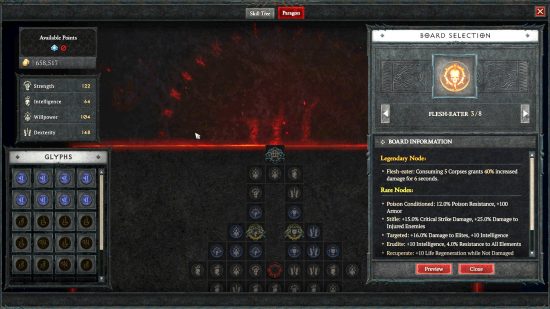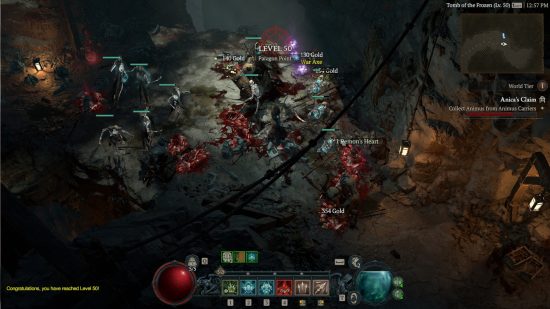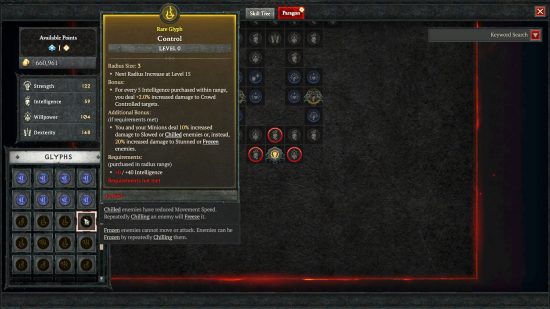How does the Paragon board work in Diablo 4? In Sanctuary, level 50 isn’t the end. Hitting the normal level cap in Diablo 4 unlocks the Paragon board, which has hundreds of circular nodes. These nodes have ability alterations, stat increases, and more associated with them. Conversely, Glyphs are slotted into special sockets on the Paragon board and have powerful effects.
Whether you’re trying to get the best builds together to take on the endgame activities or just wondering which Diablo 4 classes to focus on after the campaign, we’ve got you covered as we’ve already explored Diablo 4 way beyond the main story. So here’s everything you need to know about the Diablo 4 Paragon board and Glyphs.
How to unlock the Diablo 4 Paragon board
Upon reaching level 50, you will immediately unlock the Paragon board. After that, you will earn a Paragon Point for every 25% of a level you gain up to level 100, making a maximum of 200 Paragon Points attainable.
You can slot these Paragon Points into circular nodes on a sprawling skill tree in the ability menu (click the Paragon board tab at the top of the screen. Note that it doesn’t unlock until you hit level 50). You must unlock a node to be able to select an adjacent node. Nodes have several types:
- Normal Nodes: These nodes provide small increases to your base stats (Strength, Intelligence, Willpower, Dexterity).
- Magic Nodes: These nodes increase stats further or provide health and damage buffs.
- Rare Nodes: These nodes feature potent effects that have additional boosts by meeting stat requirements within the Paragon board.
- Legendary Nodes: Only one can be found on each non-starter board. They have powerful effects that define playstyles within your class.
- Glyph Sockets: Only one can be found on each board, including the starter board. You can slot powerful Glyph abilities into them.
- Board Attachment Gate: Once selected, this will unlock another board you choose to fill in.
Once a board Attachment Gate is unlocked, you can add additional, build-specific Paragon boards. The Necromancer, for example, has the Cult Leader board, focused on buffing minions, and the Flesh-Eater board, which has a Legendary Node that exceptionally powers up the iconic Corpse Explosion skill. Each class has nine of these boards, including the starting board.
As it takes a while to fill up each board, which one you choose to focus on will significantly alter how your character plays. If this all sounds complicated, you aren’t alone! Don’t worry, though: if you make a mistake, you can refund Paragon Points for a small price much the same way you can refund Skill Points.
How to find and use Glyphs in Diablo 4
Upon unlocking the Paragon board, you will automatically unlock eight Magic Glyphs. You can slot them into the Paragon board once you earn enough Paragon Points to unlock a Glyph Socket. In their base form, they have a radius of two, which means they gain effects from Nodes within two spaces on the board. However, this radius size can be increased – more on that later.
To unlock Rare Glyphs, continue playing Diablo 4 on the World Tier 3 Nightmare difficulty or higher. Some dungeons, such as Nightmare dungeons, might have a higher chance of dropping a Rare Glyph.
Rare Glyphs have more powerful effects. For example, a Magic Glyph for the Necromancer has a bonus that raises Minion damage by +0.5% for every other intelligence-buffing node within range. On the other hand, a Rare Glyph features a similar bonus along with an additional bonus, such as hitting slowed and chilled enemies for +10% damage.
These additional bonuses require a certain amount of stats earned within its radius. The previous example requires you to have 40 intelligence within its range. To increase the range and fulfill these requirements, you have to level up your Glyphs.
How to level up Diablo 4 Glyphs
To make the most out of Glyphs and your character build, you have to level them up. The only way to level up Glyphs is to earn experience through endgame Nightmare Dungeons. When you make Nightmare Sigils take on these challenging experiences, your chosen Glyph will level up as you complete the dungeon. The more difficult the dungeon, the more experience you will earn for your Glyph.
Along with Unique items, Diablo 4 is definitely the most build-diverse entry in the series yet. To find out just how customizable it is, why not check out our guide to transmog in the game? If you’re looking for something different, our Diablo 4 tips and hints hub has every guide we’ve created for Diablo 4.



